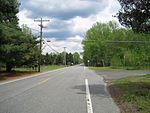New Jersey is a state situated within both the Mid-Atlantic and Northeastern regions of the United States. It is the most densely populated of all 50 U.S. states, and is situated at the center of the Northeast megalopolis. New Jersey is bordered on its north and east by New York state; on its east, southeast, and south by the Atlantic Ocean; on its west by the Delaware River and Pennsylvania; and on its southwest by Delaware Bay and Delaware. At 7,354 square miles (19,050 km2), New Jersey is the fifth-smallest state in land area, but with close to 9.3 million residents as of the 2020 United States census, its highest decennial count ever, it ranks 11th in population. The state capital is Trenton, and the state's most populous city is Newark. New Jersey is the only U.S. state in which every county is deemed urban by the U.S. Census Bureau with 13 counties included in the New York metropolitan area, seven counties in the Philadelphia metropolitan area, and Warren County part of the heavily industrialized Lehigh Valley metropolitan area.
New Jersey was first inhabited by Paleo-Indians as early as 13,000 B.C.E., with the Lenape being the dominant Indigenous group when Europeans arrived in the early 17th century. Dutch and Swedish colonists founded the first European settlements in the state, with the British later seizing control of the region and establishing the Province of New Jersey, named after the largest of the Channel Islands. The colony's fertile lands and relative religious tolerance drew a large and diverse population. New Jersey was among the Thirteen Colonies that supported the American Revolution, hosting several pivotal battles and military commands in the American Revolutionary War. On December 18, 1787, New Jersey became the third state to ratify the United States Constitution, which granted it admission to the Union, and it was the first state to ratify the U.S. Bill of Rights on November 20, 1789.
New Jersey remained in the Union during the American Civil War and provided troops, resources, and military leaders in support of the Union Army. After the war, the state emerged as a major manufacturing center and a leading destination for immigrants, helping drive the Industrial Revolution in the U.S. New Jersey was the site of many industrial, technological, and commercial innovations, including the first town (Roselle) to be illuminated by electricity, the first incandescent light bulb, and the first steam locomotive. Many prominent Americans associated with New Jersey have proven influential nationally and globally, including in academia, advocacy, business, entertainment, government, military, non-profit leadership, and other fields.
New Jersey's central location in the Northeast megalopolis helped fuel its rapid growth and suburbanization in the second half of the 20th century. Since the beginning of the 21st century, the state's economy has become highly diversified, with major sectors including biotechnology, pharmaceuticals, information technology, finance, and tourism, and it has become an Atlantic seaboard epicenter for logistics and distribution. New Jersey remains a major destination for immigrants and is home to one of the world's most ethnically diverse and multicultural populations. Echoing historical trends, the state has increasingly re-urbanized, with growth in cities outpacing suburbs since 2008.As of 2022, New Jersey had the highest annual median household income, at $96,346, of all 50 states. Almost one-tenth of all households in the state, or over 323,000, are millionaires, the highest representation of millionaires among all states. New Jersey's public school system consistently ranks at or among the top of all U.S. states. According to climatology research by the U.S. National Oceanic and Atmospheric Administration, New Jersey has been the fastest-warming state by average air temperature over a 100-year period beginning in the early 20th century, which has been attributed to warming of the North Atlantic Ocean.






